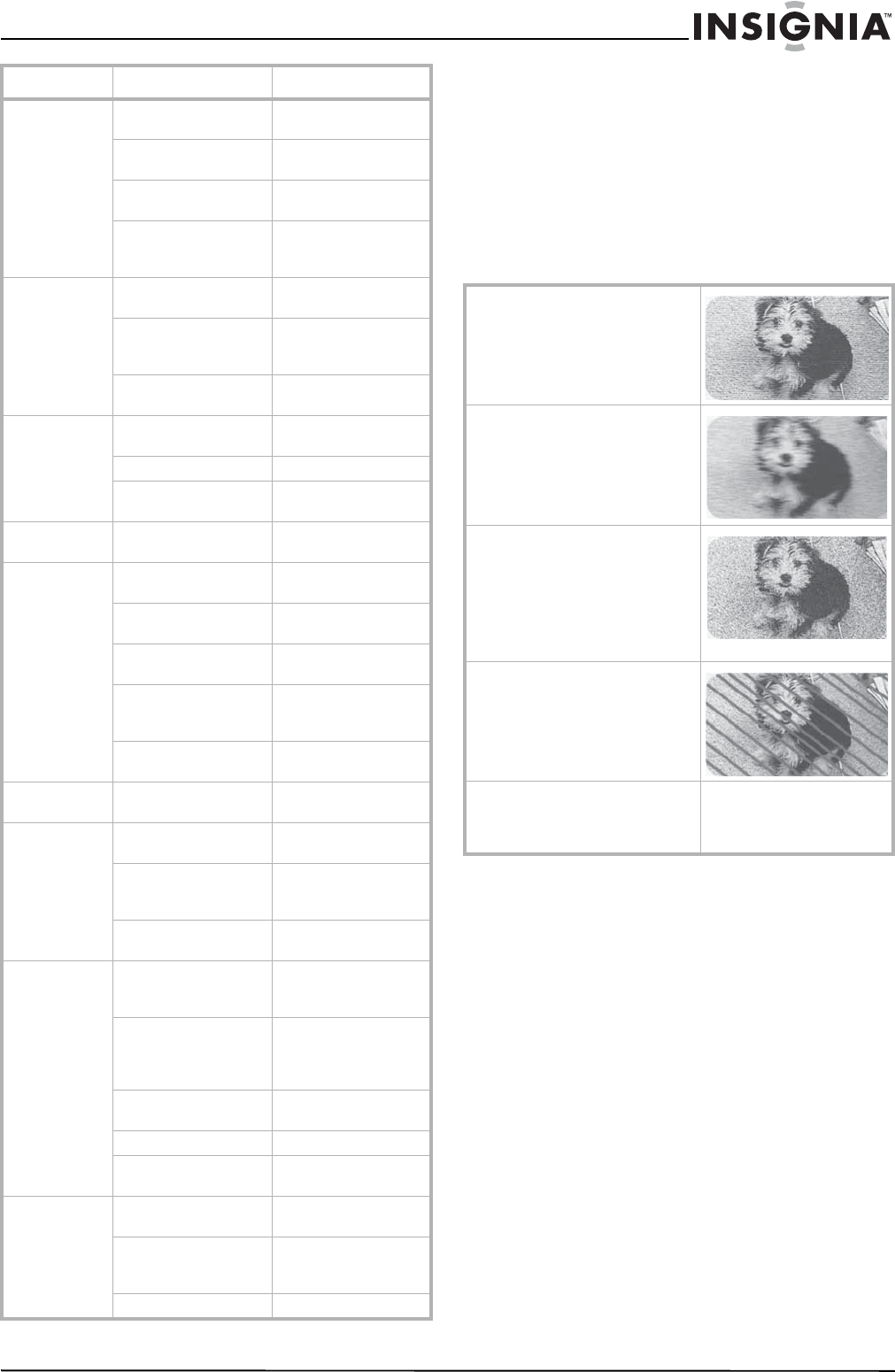
17
Insignia NS-F27TV Television
www.insignia-products.com
Reception disturbances
Most types of television interference can be
remedied by adjusting the height and position of
the VHF/UHF antenna. Outdoor antennas are
recommended for best results if not using cable
or satellite. The most common types of television
interference are shown below. If one of these
symptoms appear when the television is
connected to a Cable TV system, the
disturbance may be caused by the local cable
company broadcast.
Poor or no
picture
TV station is
experiencing problems.
Try another channel.
Picture control is not
adjusted.
Check picture control
adjustments.
Possible local
interference.
Check for source of
reception disturbance.
Antenna/cable
connector is not
connected.
Check cable connection
or VHF/UHF antenna.
Picture wobbles
or drifts
TV station experiencing
problems.
Try another channel.
Cable TV channel is
scrambled.
A cable box needs to be
used to receive this
channel.
Possible local
interference.
Check for source of
reception disturbance.
No cable
reception
Cable not connected. Check all cable
connections.
Air/Cable set to Air. Set Air/Cable to Cable.
Cable TV service
interrupted.
Contact your cable TV
company.
No reception
above CH13
Air/Cable set to Air. Set Air/Cable to Cable.
Poor or no
sound
TV station experiencing
problems.
Try another channel.
MUTE button is
pressed.
Press MUTE button
again.
Possible local
interference.
Check for source of
reception disturbance.
Antenna/cable
connector is not
connected.
Check cable connection
of VHF/UHF antenna.
Volume is set to
minimum.
Increase the volume.
Television shuts
off
Sleep timer is set Set sleep timer to OFF.
Closed
Captioning not
working
TV signal is weak. Check cable or
VHF/UHG antenna.
TV station experiencing
problems or program is
not closed captioned.
Try another channel.
Close captioning is not
turned on.
Press the CCD button.
Remote control
does not
operate
The remote control is
not aimed at the
sensor.
Aim the remote control
at the remote sensor.
Distance is too far or
too much light in the
room.
Operate the remote
within 15 feet of the
television or reduce the
light in the room.
There is an obstacle in
the path of the beam.
Clear the path of the
beam.
The batteries are weak. Replace the batteries.
The batteries are not
inserted correctly.
Reinsert the batteries.
Parental control
not working
correctly.
Parental control is set
to OFF.
Set parental control to
ON.
News or sports event
being broadcast.
Parental control does
not work with news or
sporting events.
Ratings not set. Set ratings.
Symptom Possible cause Possible solution
IGNITION: Black spots or horizontal
streaks may appear, picture may
flutter or drift. Usually caused by
interference from automobile
ignition systems, neon lamps,
electric drills and other electric
appliances.
GHOSTS: Ghosts are caused by the
television signal following two
paths. One is the direct path and the
other is reflected from tall buildings,
hills, or other objects. Changing the
direction or position of the antenna
may improve the reception.
SNOW: If your receiver is located in
the fringe area of a television station
where the signal is weak, your
picture may be marred by the
appearance of small dots. When the
signal is extremely weak, it may be
necessary to install an external
antenna to improve the picture.
RADIO FREQUENCY
INTERFERENCE: This interference
produces moving ripples or
diagonal streaks, and in some
cases, causes loss of contrast in the
picture.
PICTURE SIZE VARIATION: A slight
picture size variation is normal
when you adjust the CONTRAST or
BRIGHTNESS setting.


















